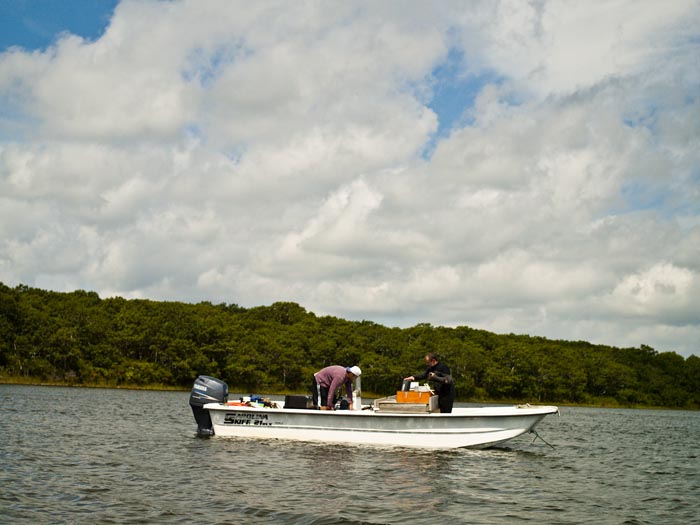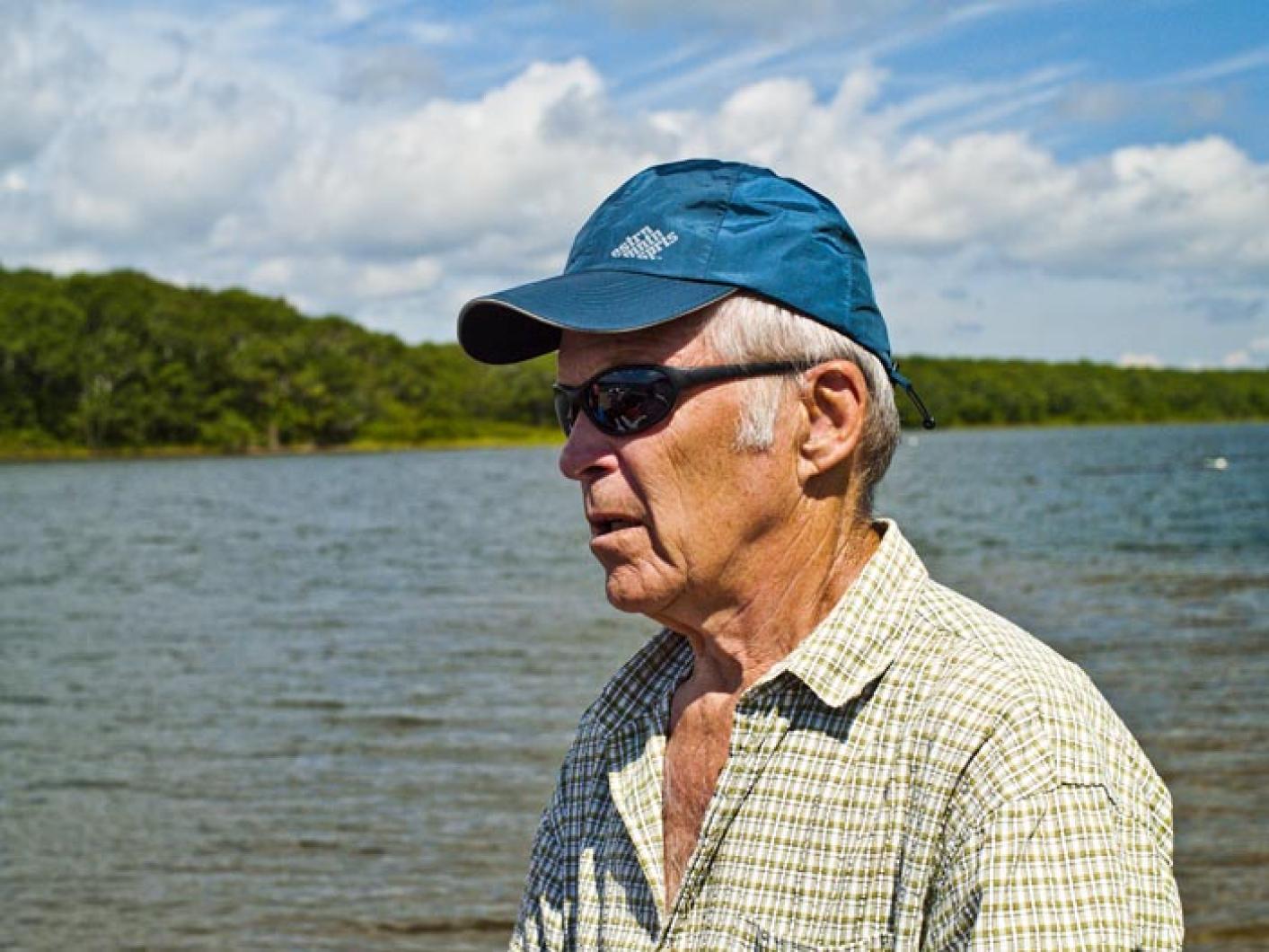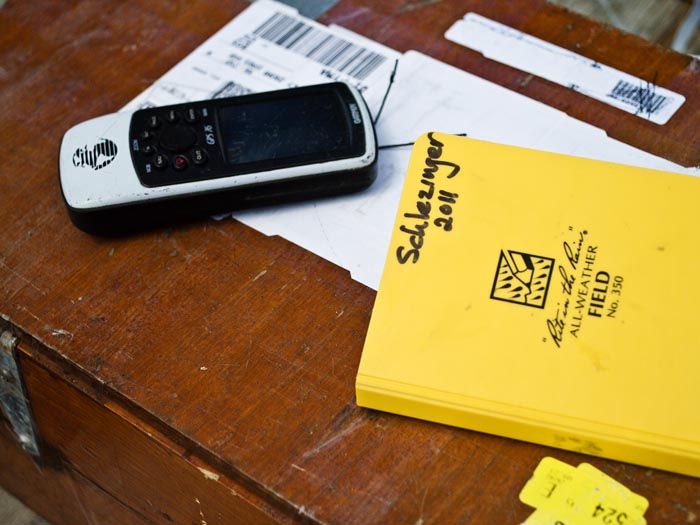Out in the middle of Meshacket Cove on the Edgartown Great Pond on Wednesday morning, David Schlezinger was going down for the third time, in nine feet of water.
He wasn’t drowning, though. It was quite the reverse. Dr. Schlezinger’s problem was his buoyancy. It’s hard to insert a long stake into the bottom of a pond when you can’t bring a lot of weight to bear on it.
Between panting breaths, he explained the situation. There was a layer of mud on the bottom, but below it was hard sand. He had to get that stake driven far enough into the sand to ensure that an expensive and fairly delicate piece of scientific equipment stayed securely in place.
“But you don’t want to use a $9,000 piece of equipment as a hammer, or an anvil,” he said.

A couple more dives, and he’d managed to fix it. The anchor was in place, with its various meters attached. The precise GPS location was plotted, and he hauled himself back aboard the boat.
Then he and his two-man support crew – Josh Hurwitz, his colleague from the coastal systems program at the University of Massachussetts Dartmouth, and Adam Brodheim, with the Great Pond Foundation’s Oyster Restoration Project — moved on.
They had still to anchor another 11 of the monitoring devices in various places on the pond, where they will remain for the next four or five weeks, measuring various aspects of the water quality of the cove.
In the near future, Mr. Schlezinger hopes also to be able also to deploy another, fancier piece of technology in the pond, something he calls an autonomous underwater vehicle, but which less scientific people would call a mini-submarine, to move around the pond between the other sensors, collecting the same kinds of data.
It is being done in the interests of improving the health of the pond, and the cost is being borne by the Great Pond Foundation.
The aim is to measure what happens to the water quality of the pond when it is opened to the sea.
The background to the study is that the Vineyard’s ponds are troubled by being loaded with too much nitrogen, which leaches in from septic systems and lawn fertilizers and even precipitates out of the air.
That nitrogen encourages the growth of algae, which can have a devastating effect on other life in the ponds.
Over recent years, various efforts have been made to lessen the nitrogen load, both by reducing the amount coming into the ponds, and by more frequent opening of the ponds to the sea, so more will be flushed out.
Edgartown Great Pond, in particular, has benefitted from more frequent openings over the past five or six years.
But, as Mr. Schlezinger explained, there remains much that is not well understood about what happens when that seawater floods in, and some concern about it.
“Although the increased flushing is helping the pond as a whole, there’s always an underlying issue that when you let all this seawater in, the pond will stratify. That is, because the seawater is colder, more salty and denser, it hugs the bottom,” he said.
“Once the water column is stratified, there is a disconnect between the atmosphere and the bottom, which limits the amount of aeration of the pond water. So there is the possibility for low oxygen events.
“And the bottom is where the bacteria are busy breaking down the organic matter. It’s like a compost heap. And they use a lot of oxygen,” he said.
Hence the need to anchor those sets of sensors down near the bottom of the pond.
“They have a battery pack and they make a record every 15 minutes of dissolved oxygen, temperature, salinity and depth,” he said.
“They also have a little miniature fluorometer which sends out a specific wavelength of light that makes the chlorophyll in the phytoplankton emit light. That’s a proxy for physically measuring the amount of chlorophyll in the water.”
The equipment has been placed in advance of the next pond opening. That way, they will get data about the water quality in the pond before it opens — which is likely to happen in the next week or so, depending on weather — during the opening, and after the breach closes.
“As that saltwater wedge moves up through the pond, we’ll be able to track it,” he said.
The hope is that the data will tell the scientists whether there are some areas of the pond that are particularly sensitive, where stratification occurs, or, alternatively, where the salt water is not effectively flushing out the nitrogen load.
“We know the pond as a whole is getting healthier, but there might be areas of the pond that suffer even short-term because of stratification or hypoxia. We just don’t know.
“It’s possible also that those problems could then be solved through changes in circulation,” he said
In other words, there could be more dredging of channels, or changes in the frequency or timing of opening.
Some landowners around the pond will be watching the results for other reasons, too.
“I know that many of the landowners would like to have spits dredged out, simply for access,” said Mr. Schlezinger.








Comments
Comment policy »